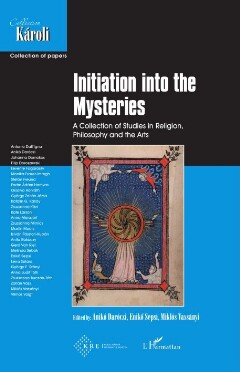Page 205 [205]
INITIATION INTO MYSTERIES IN PIco’s WORKS
more than any other philosopher in his 900 Theses: he cites 45 theses from
Aquinas.”° It is worth noting that Pico learned Aramaic and studied Kabbalah
with his tutor Flavio Mitridate, and in Kabbalah the seraphim are the higher
angels of the World of Beriah, “Creation,” that is the first created realm which
is divine understanding.
According to Pico’s explanation, before we could reach this highest level
of love, we need to prepare ourselves by meditation, that is by imitating the
cherub when contemplating. As we are humans, he says, we do not know
how the cherub can contemplate God immediately. Thus, we have to learn
this from the Church Fathers: from Saint Paul, who ascended into the
third heaven, and his disciple, Dionysius the Areopagite, who explained in
the Celestial Hierarchy (Chapter VII, 1-4.) what Paul could see there.” Again,
at this point Pico defines an order, where Pseudo-Dionysius specificed parallel
activities. This is Pico’s definition: “[Paul] saw them [the cherubs] first being
purified, then illuminated, then finally made perfect.””’ In the Areopagite’s
description, these three actions are peculiar to all three types of angels,
which for me seem to be one, that is the same one having three different
aspects: “the first hierarchy of heavenly minds [...] is filled with its due
measure of utter purification, of infinite light, of complete perfection.””*
When Dionysius explains in more detail, he does not offer a strict order of
action: “Purification, illumination and perfection are all three the reception
of an understanding of the Godhead, namely, being completely purified of
ingnorance by the proportionately granted knowledge of the more perfect
initiations, being illuminated by this same knowledge, (through which it
also purifies whatever was not previously beheld but is now revealed through
the more lofty enlightement), and being also perfected by this light in the
understanding of the most lustrous initiations.”
is ‘heat, which is not found in fire simply, but exists with a certain sharpness, as being
of most penetrating action, and reaching even to the smallest things, and as it were, with
superabundant fervor; whereby is signified the action of these angels, exercised powerfully
upon those who are subject to them, rousing them to a like fervor, and cleansing them wholly
by their heat. Thirdly we consider in fire the quality of clarity, or brightness; which signifies
that these angels have in themselves an inextinguishable light, and that they also perfectly
enlighten others.” Thomas Aquinas, Summa Theologiae, Cristian Classics Ethernal Library,
http://www.ccel.org/ccel/aquinas/summa.pdf 1* part, Treatise on the angels, Question 108.
Of the angelic degrees of hierarchies and orders. Article. 5 — Whether the orders of the
angels are properly named? 1187-1188.
Only Proclus and the Kabbalist philosophers are cited more frequently, with 55 references to
Proclus and 47 references to the Kabbalist philosophers.
Like Ficino, Pico did not share Lorenzo Valla’s doubts about the author of these books being
Paul’s disciple.
Caponigri’s translation. “Respondebit utique Dionysio interprete: purgari illos, tum
illuminari, postremo perfici.” Pico Della Mirandola, De hominis dignitate, 110.
28 Pseudo-Dionysius, The Celestial Hierarchy, VII, 209C. The Complete Works, 165.
3 Tbidem.
25
26
27
+ 203 ¢
Daréczi-Sepsi-Vassänyi_Initiation_155x240.indb 203 6 2020.06.15. 11:04:20

